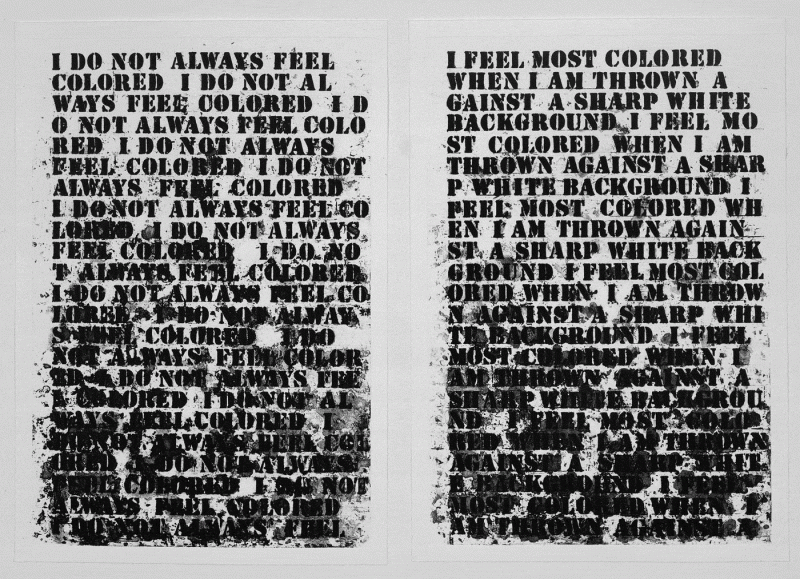NON-BINARY DESIGN IN THE PURSUIT OF INCLUSIVE VISUAL “COMMONS”
Posted on October 26, 2018“Growing numbers of people are taking steps that move us, gradually, in the direction of a commons-based society — a world in which the fundamental focus on competition that characterizes life today would be balanced with new attitudes and social structures that foster cooperation.”
Jay Walljasper (2010)

Figure 1. © 1990–91, Untitled (Four Etchings) 1992 (A), courtesy of Glenn Ligon and Luhring Augustine, New York.
In her writing on the “Art of Commoning”, Elinor Ostrom, Nobel Prize recipient for Economics, describes the practice of “commoning” as dealing primarily with “relationships and belonging…it is a practice of relating to ‘others’ from within the narrative of interbeing rather than separation” [1]. In an increasingly polarized world, a paradigm shift has been born of a call to consciousness led by academic and activist organizations from the political left. There has been a movement away from the use of binary language, as it pertains to identity (kinship systems), in the aim of creating a safe and inclusive “commons”. It seems, however, that this movement to reimagine a non-binary lexicon exists for the most part in the spoken or written realm of language. Why not expand this pursuit of an inclusive, non-binary commons to include the “visual commons”? In the scope of design, practitioners are potential allies with a certain amount of privilege and pull within a historically elitist/expert industry approach to imagining futures. Bordieu describes this tendency in design to maintain a problematic or non-inclusive status quo as “symbolic violence”. Bourdieu describes ‘symbolic violence’ as “a gentle violence, imperceptible and invincible even to its victim, exerted for the most part through the purely symbolic channels of communication and cognition (or miscognition), recognition, or even feeling” [2] . Perhaps the next step in imagining a truly inclusive commons, is to include the aesthetic element of design as part of the greater lexicon of inclusive expression. By way of the polemics of binary thinking, we can begin to adopt a more holistic understanding of “commoning” in which visual (as well as linguistic) markers are understood as a key indicator in kinship systems.
REIMAGINING A NON-BINARY VISUAL LEXICON
In order to begin to question the role that aesthetic design plays in supporting (or inhibiting) non-binary commoning, we must first dissect how certain visual elements are tied to identity formation and kinship systems as much as elements of language are. There has been ample study demonstrating how the language we use is incredibly important in creating kinship systems. In A Thousand Years of Non-Linear History, Manuel De Landa dissects this relationship between language and kinship, noting that “the sounds, lexicon, and grammatical patterns characteristic of a local dialect are part of the shared values that bind the members of a dense network together and hence communicate information about solidarity and loyalty” (3). Put simply, the subtle changes in dialect (sounds, accents, grammatical patterns, regional slang, etc) can speak volumes to our loyalties, values, and where we situate ourselves in terms of our cultural kin. The visual components of language and self-expression are equally powerful as threads in the fabric of identity, and these bound elements of design and kinship should be studied and held by designers in our ever-growing ‘toolbox’ for the pursuit of helping to build inclusive, ‘non-violent’ futures.
DESIGNERS AS ALLIES IN A NON-BINARY FUTURE
Though there are infinitely complex and interconnected visual indicators of kinship, a simple and clear example can be made of the way in which we align certain identities with colors. One such example that saturates our visual landscape are the colors RED and BLUE. These two colors are used to express allegiance to certain nations, as they represent the colors of a flag. If used for garments they can represent affiliation to a specific sports team or school. These colors are used, perhaps most iconically, to represent opposing political parties in a greatly bipartisan nation. In areas of the country afflicted with gang violence, one can walk down the street and literally map block-by-block gang affiliations by the presence of these colors in graffiti or bandanas worn to display group association. The blood that runs through our very own veins takes on the colors of red or blue depending on the direction that it flows, away from or towards the heart. These two primary colors, when boiled down to their purest form, in their essence insinuate an inherent opposition. It is the responsibility of designers to be conscientious of these elements of our visual language that may denote the kind of polarity that inhibits inclusive “commoning”. As an act of ‘symbolic violence’, we as designers may be subconsciously contributing to an antagonism by upholding a visual status quo that depends on visual binaries. The future of visual commoning depends on conscious designers to exercise their privileged position, and to embrace ally-ship as a driving force in modern design practice.
– Erica Eisenberg
1. Wahl, Daniel Christian, and Jonathan Dawson. “Learning the Art of Commoning – Age of Awareness – Medium.” Medium. March 11, 2018. Accessed October 25, 2018. https://medium.com/age-of-awareness/learning-the-art-of-commoning-db7299470f49.
2. Boehnert, Joanna, and Dimeji Onafuwa. “Design As Symbolic Violence : Reproducing the ‘Isms’ a Framework for Allies.” Intersectional Perspectives on Design, Politics and Power, November 14, 2016. Accessed October 25, 2018.
3. Landa, Manuel De. A Thousand Years of Nonlinear History. New York, NY: Zone Books, 2014.